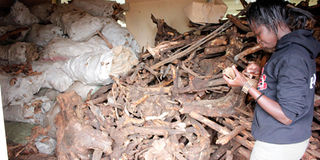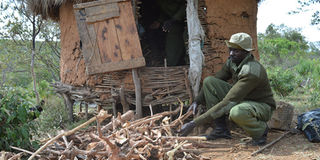Breaking: Autopsy reveals how Cyrus Jirongo died
Premium
How illegal sandalwood trade thrives in full glare of authorities

Samburu County Police Commander Karanja Muiruri (right) and Waso Assistant County Commissioner Bernard Onyango (left) display sandalwood that police impounded in Archers Post, Samburu, in April 2019. VIVIAN JEBET | NATION
The succession of plains and the undulating sinusoidal hills and canyons from Samburu Central to Baragoi in the north and Archers Post on the Samburu-Isiolo border make one of the most scenic swathes of Kenya’s landscape.
The scenery is pristinely alluring and tantalising to the eye, teasing any visitor with mystic beauty. The heavenly, blissful beauty leaves one gasping for breath.
But beneath the idyllic veneer of a lover’s safari paradise is a haven of the deadly multibillion-shilling sandalwood business that threatens the existence of the second-most expensive wood in the world.
Here, the tree is illegally harvested, loaded into vehicles — mostly private, government and ambulances — and transported through roads to other countries, where the sandalwood business thrives, and the government has imposed no restrictions.
Sandalwood (whose scientific name is Osyris lanceolate) is the second-most expensive wood in the world, after the African blackwood that grows in Senegal, Eritrea and South Africa.
PERFUMERY USE
The tree is much sought after because of its use in perfumery and due to restrictions imposed on its harvesting in many parts of the world.
Investigations by the Nation can now reveal the shocking details of the deadly sandalwood business and the intricate web of lethal cartels behind the illegal trade. The cartel will conduct the dirty business at all costs, even killing those who try to stand in their way.
Despite repeated government pronouncements that it will eradicate the lucrative trade and preserve the near extinct tree, there has been little success.
Since its ban in April 4, 2007 by President Mwai Kibaki, government agencies have issued pronouncements against the trade, but none has shown the capacity to end it.
NETWORK GROWS
In fact, the more pronouncements and vows government agencies make, the bigger, bolder and smarter the network grows.
We unearthed a complex network of cartels involved in the illegal business and how the trade is turning traders into overnight millionaires.
The tree is harvested illegally in several parts of Samburu, Pokot, Baringo and other parts of the North Rift.
However, the epicentre of this trade is Samburu. Mr Charles Ochieng, the county forestry conservator, admits that cartels had made the region a playground for the illicit trade.
“I am aware of the illegal sandalwood business that has become deep-rooted in Samburu County. The most affected places include Samburu East, Baragoi and Wamba. However, the Kenya Forest Service (KFS) is working jointly with various government agencies, including the police and the Kenya Wildlife Service, to contain the illicit business,” Mr Ochieng said.
The business is booming."
KFS and its partners, he said, have intensified patrols to combat the illegal harvesting of indigenous and endangered tree in Samburu forests.
But it is not just in Samburu that the endangered tree is being ravaged. Mombasa, Baringo, Nakuru, Laikipia and Isiolo are the other epicentres. The trade goes on in the full glare of law enforcement agencies as the wood is ferried through numerous police checkpoints, including in Eldoret or Nakuru towns.
“The business is booming. With ready markets in Uganda, Saudi Arabia, India and elsewhere, the cartel running the trade has become huge as it wields a lot of power in critical state agencies,” revealed a source who acts as an agent in the trade.
For instance, in October 2018, detectives seized a container of 16.9 tonnes of endangered sandalwood at the port of Mombasa.
SAUDI ARABIA
The 20-foot container, security sources said, was exported from Uganda and was destined for Saudi Arabia.
The wood had been ground and packed in sacks.
Investigations reveal that the well-connected cartel ferries sandalwood from the Samburu forests to Uganda, through the porous Busia border, and the forest produce is ground before it is repackaged in containers ready for export.
“The cartels link up with unscrupulous port officials, including clearing agents to allow the products back into Kenya in readiness for export to other countries overseas,” a senior Kenya Revenue Authority official revealed to the Nation.
In fact, some of the State agencies now thrive on the same vice, which they are tasked with fighting.

Impounded sandalwood in a store at the Kabarnet Police Station in Baringo in December 2015. CHEBOITE KIGEN | NATION
The cartels include prominent politicians, administrators and security officials who have made it almost impossible to bring the illegal trade under control, making the extinction of the endangered plant a near certainty.
Interviews with several residents of Samburu County revealed that the cartels enlist emissaries who are masters of the treacherous terrain. From the panya (unofficial) routes, to collection centres, local smugglers have mastered all the tricks in the book to sustain their trade.
“The cartels usually have armed protectors and informers along specific routes commonly used to ferry the lucrative wood to the market. They have recruited an armed militia to protect their operations,” revealed Mr James Lentoimaga, a resident of Baragoi. The cutters prepare the wood for sale while local middlemen oversee the further chopping of the wood and transportation out of the forest.
SHIPPING WOOD
Tycoons, who are the masters in the game, then help in shipping the wood, mostly in tonnes, to overseas markets.
Unsurprisingly, the dirty business has turned deadly. Those behind the vicious trade ring have been linked to killings, kidnappings and intimidation in Samburu.
The dealers live brutal and ruthless lives. They hire gunmen to intimidate and sometimes murder rivals or government officials who attempt to disrupt the business.
“Sandalwood smuggling has become a very risky business. But it is extremely profitable. There is a booming international market. Therefore, police officers, administrators or government officials who attempt to block the trade are sometimes transferred or even threatened by the well-connected cartels to scare them out of the way,” said a senior security officer privy to the operations of the cartels.
DRIVER KIDNAPPED
Last year, a KWS driver was kidnapped after he failed to execute the killing of four people, among them government officials, who appeared to introduce hurdles in the way of the cartels, a source told the Nation.
“The driver was kidnapped minutes after dropping off his boss at the KWS Training Institute in Naivasha. He was abducted and held in a house in Mwiki, Nairobi, for about two weeks before he was freed after the involvement of senior government officials and detectives,” the source said.
To conceal their trade, dealers in the trade are now using expensive vehicles like Toyota Land Cruiser Prados and Land Cruiser V8s.
Two of several motor vehicles seized at the Maralal Police Station are Toyota Land Cruiser Prados.
SOFT UNDERBELLY
Although the cartels exploit the soft underbelly of the security agencies in Samburu, hardly a month passes without a motor vehicle or motorcycle transporting the wood being seized in the county. Impunity, greed and wanton disregard for the environment have taken their toll on both communal and other State-controlled forests.
Various police stations in Samburu East, Samburu Central and Samburu North have at least one or two motor vehicles seized ferrying sandalwood.
The Nation learnt that in the past one month alone, more than Sh50 million worth of sandalwood has been impounded in Samburu County.
However, there are many other cases that are not reported, where police officers connive with the cartels to sneak sandalwood out of Samburu to the markets.
We will not tolerate cartels involved in this illegal sandalwood trade."
Some of the routes mostly used to ferry sandalwood out of Samburu include the Wamba-Sura Adoru-Suguta road, the Isiolo-Marsabit highway to the Lerata junction and the Wamba-Sura Adoru-Suguta-Rumuruti-Nyahururu-Nakuru road.
Samburu County Police Commander Samson Ogello said at least seven cases involving motor vehicles seized ferrying sandalwood are active in courts.
“The cases are being handled mainly at the Maralal and Wamba law courts. We will not tolerate cartels involved in this illegal sandalwood trade. Those involved will face the full force of law,” Mr Ogello told the Nation.
The police boss revealed that security personnel have increased their patrols in various parts of Samburu to tame the trade.
“We have intensified crackdowns to arrest the criminals involved. I urge residents to be vigilant and to always report members of the cartels to help police arrest culprits. Security agents are ready to crush this cartel,” said the police boss.
'DAYS NUMBERED'
But when asked whether he was aware that police officers sometimes dabble in the trade, Mr Ogello said: "Sometimes there are rogue officers who experiment in crime, but such officers have their days numbered".
Last November, police, with KFS and KWS officials, destroyed sandalwood with a street value of Sh44 million at the Maralal Police Station after obtaining a court order.
The illegal consignment, believed to have originated from the Samburu East communal forest, was confiscated from two loggers arrested on the Wamba-Maralal road.
But this seems not to have bothered the dealers, who continue to operate the lucrative business. Thousands of tonnes of sandalwood logs are illegally ferried out of the vast, rolling jungles of Samburu County, feeding an international trafficking network stretching from Samburu to Pokot, Baringo, Nakuru and other parts of the North Rift. Sandalwood is smuggled from Kenya to the international market involving Uganda, Malasyia, China, Australia, Dubai, Indonesia and Sri Lanka, with India dominating the global sandalwood oil market.
Villagers in areas where the tree grows sell one kilogramme of sandalwood for a pittance — Sh100 to Sh200 — while the traders who smuggle it out of the country sell it for as much as Sh150,000 on the international market, minting millions of shillings.
“Most of the locals are involved in the preparation and sale of sandalwood. Sometimes dealers promise to pay once they manage to evade police dragnets all the way to the market. Sometimes we are not sure of our payments,” Mr Leleshipai told the Nation.
With such huge sums at play, several people are involved in the trade to ensure the sandalwood arrives at the markets.
Local youths are hired as woodcutters, transporters or middlemen.
PREPARING WOOD
For instance, when the Nation team visited Ndume Forest, it came face to face with a group of youth, in a secluded place, deep inside the forest, preparing sandalwood for sale.
We were welcomed by heaps of sandalwood ready for the market and loads of raw ones too.
Yet the woodcutters and transporters hired to prepare the sandalwood for the market remain impoverished, even as their millionaire masters smile all the way to the bank, after bribing their way to global markets.
“We know the wood is expensive on the international market, but we have no option but to accept the little payment because we cannot manoeuvre and make it to the market by ourselves,” said a local hired to chop the precious wood in Ndume.
Investigations reveal that the smuggling syndicate runs deep into government agencies, including those meant to fight the illegal trade.
DISHONEST POLICE
The well-connected cartel involves rogue police officers, corrupt KFS officials, business people and well-connected prominent people.
Some of those already being investigated in connection with the illegal trade, documents seen by the Nation show, include Ms Agnes Nasieku, a business woman based in Loitoktok, who is said to have at least Sh100 million in one local bank account.
Others are a Mr David Mucheru, based in Nakuru, and Ms Emma Wanjiku, alias Mama Jimmy. Detectives are also investigating senior government officials and prominent people believed to be behind the illegal trade.
The Nation is in possession of documents, including receipts, showing dealings between the persons under investigations and KFS.
MOVEMENT PERMITS
For instance, Mr Mucheru has until recently (January 2020) been obtaining Forest Produce Movement permits from rogue KFS officials, which he uses to advance the illegal trade.
When reached for comment, Samburu Forestry conservator Ochieng distanced his office from the dealings.
“I am not aware of any case involving a KFS official. KFS does no issue permits to harvest sandalwood,” he said in an interview at his office in Maralal.
Instead, Mr Ochieng lamented that Samburu, with at least 328,000 hectares of indigenous forest cover, lacks enough forest rangers to tame the illegal sandalwood harvesting.
“We only have 15 forest rangers manning government forests in the entire county and only one vehicle serving four forest stations, making mobility difficult.
“Nevertheless, we are working with other government security agencies to fight the illegal harvesting of sandalwood in the region,” he said.
We have been arresting people, but we lose cases in court."
The forest cover manned by KFS includes the Matthews (or Mathews) Range, South Horr forest station, and the Ndotto, Rirugi and Mount Nyiro forest reserves.
Mr Ochieng revealed that Samburu East is the most affected in the harvesting and smuggling of sandalwood.
The KFS boss also blamed the Judiciary and the office of the Director of Public Prosecutions, saying they had failed in the fight against the business.
“We have been arresting people, but we lose cases in court. I urge the two agencies to help us jail culprits to serve as examples to would-be offenders. We need to protect these indigenous tree by all means,” said the KFS boss.
Mr Ochieng revealed that sometimes the main culprits are never arrested, but are left working closely with rogue police investigators to destroy evidence.

Administration Police and Kenya Wildlife Service officers at one of seven huts along the Laikipia and West Pokot border where a total of 14 tonnes of sandalwood was seized in 2016. STEVE NJUGUNA | NATION
A senior investigator revealed that rogue police officers and other government officials are often bribed to abet the crime.
“There is deep-rooted corruption that runs from sandalwood dealers to rogue police officers, KFS officials and other government officials tasked with barring the illegal trade. Lorries, motorcycles and other small motor vehicles ferry the forest produce at night along specific routes to specific destinations,” said the officer, who sought anonymity.
The ban on sandalwood harvesting was imposed by President Kibaki in a Kenya Gazette notice on April 4, 2007, under the protected tree species law.
Sandalwood is harvested from trees of between 20 and 30 years old and the tree is valuable from the leaves to the roots, making it much sought after.
PREVENT OVER-EXPLOITATION
Many countries have put in place mechanisms to protect the tree from over-exploitation. Some in the Far East have been compelled to source the raw materials from other parts of the world, with East Africa being a major source.
The foreign demand has created an incentive for the increased illegal exploitation that is prevalent in protected areas. Sandalwood is already depleted in unrestricted areas.
Crude harvesting methods are employed where the plant is wholly uprooted, further damaging the environment.
There are two types of sandalwood — the Indian and the East African. The East African variety faces a serious threat of extinction if its illegal exploitation continues unabated.
A 2018 report, Task Force to Inquire into Forest Resources Management and Logging Activities in Kenya, revealed that illegal logging of indigenous trees is rampant in key forest areas. Sandalwood was found to be among the most targeted tree species besides cedar.
JOINT APPROACH
The task force recommended that KFS, KWS, national security agencies, county governments and the relevant conservancies develop and implement a joint law enforcement approach to combat the illegal logging of sandalwood.
Sandalwood is exploited for its essential oils used in perfumery.
The wood is heavy, yellow and fine-grained, and, unlike many other aromatic woods, it retains its fragrance for decades.
Sandalwood oil is also extracted from the wood.
Both the wood and the oil produce a distinctive fragrance that has been highly valued for centuries.
SPECIES OVERHARVESTED
Consequently, species of these slow-growing trees have suffered overharvesting.
The heartwood of the trunk, main branches and roots contain an essential oil. This oil blends so well with many fragrance materials that it has become a common blender-fixative used in numerous perfumes.
The tree grows to a height of one to six metres, but the roots are most favoured as the essential oil concentration is highest in them, followed by the trunk.
The tree is dioecious (male and female on separate trees) and the female is most preferred as it is said to have a better quality of heartwood.
SWEET FRAGRANCE
Traditionally, Hindus, Buddhists, Muslims and Chinese have for decades used sandalwood as incense for its sweet fragrance in their festivities.
In some countries, such as Indonesia, finely ground sandalwood mixed with water is rubbed on the body to provide a cooling effect. It is also used for making highly prized walking sticks and jewel boxes.
In Kenya, sandalwood is of value to different communities in various ways. Its fruits are edible while the roots are used as a remedy for diarrhoea and snake bites, while its root fibres are also used in basketry.
Products from sandalwood are highly valued in China and the Middle East, helping boost the underground trade.





